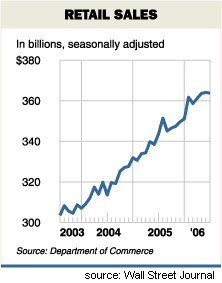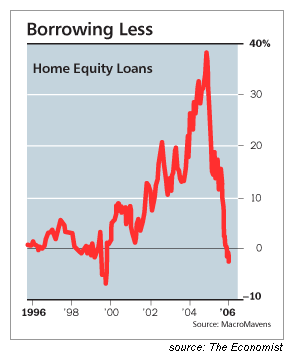

|
| weblog/wEssays archives | home | |
|
Retail Sales and Rising Debt: Could They Be Connected? (July 19, 2006)  Retail sales, after years of steady growth, has finally faltered. Since wage growth
has been essentially flat since 2001, we have to wonder: where did all that money come from, if
not from wages?
Retail sales, after years of steady growth, has finally faltered. Since wage growth
has been essentially flat since 2001, we have to wonder: where did all that money come from, if
not from wages?
Here's part of the answer: The amount of outstanding credit card debt has more than quadrupled since 1990, to $696.7 billion, according to CardWeb.com. If we look at the growth in retail sales from 2003, and then look at the amount of home equity loans taken out in the same time frame, another source of funds is rather obvious: HELOCs, or home equity lines of credit. In sum: that lovely, profitable rise in retail sales was borrowed money, funds drawn off credit cards or home equity lines of credit or via re-financing of existing mortgages at higher balances.  Somewhat less obvious is another source of spending money: the savings gained by re-financing
a higher-interest fixed-rate mortgage to a lower ARM (adjustable-rate mortgage):
Somewhat less obvious is another source of spending money: the savings gained by re-financing
a higher-interest fixed-rate mortgage to a lower ARM (adjustable-rate mortgage):
According to the Office of Federal Housing Enterprise Oversight, the volume of ARMs tripled between 2001 and 2004, from $304 billion to $985 billion in 2004. At the end of 2004, there were about $1.4 trillion in ARMs outstanding. That figure is likely significantly higher today, since the ARMs accounted for about 31 percent of the $2.9 trillion in mortgages issued in 2005, according to the Mortgage Bankers Association. For every 100 basis points (i.e., 1 percent) mortgage rates rise, holders of adjustable of ARMs will owe an extra $14 billion per year in interest. Here's more evidence that American homeowners have been pulling equity out of their homes in an orgy of re-financing: 
Re-Fi's Hit a 15-Year High: A greater proportion of mortgage refinancers tapped their home equity for cash in the first three months of this year than in any other quarter in the past 15 years, according to an analysis released yesterday.  88 per cent is a very hefty majority. Shall we connect the dots? How can anyone
conclude that the current "prosperity" reflected in those wonderfully ever-rising retail
sales is anything but borrowed money being spent (or shall we be honest and
say wasted?) on non-productive services and goods such as vacations, furniture and
Chinese-made gew-gaws?
88 per cent is a very hefty majority. Shall we connect the dots? How can anyone
conclude that the current "prosperity" reflected in those wonderfully ever-rising retail
sales is anything but borrowed money being spent (or shall we be honest and
say wasted?) on non-productive services and goods such as vacations, furniture and
Chinese-made gew-gaws?
Even money poured into home improvements isn't really productive; a new granite countertop doesn't really add much to the value of a home (especially when it's dropping like a stone), nor does it create income. All the "investment" in housing and home improvement made during the bubble is essentially money that has been mis-allocated into non-productive assets (rental housing excepted). Now that the heavy borrowing off home equity is drawing to a close (see above chart), the weight of all that "dead money" dumped into housing is starting to weigh on consumers. The dead money generates no income, but the loans made still have to paid. And as all those interest-only loans click over to loans which require payment of principal, the "pinch" felt by consumers will become a bone-crushing vice. For more on this subject and a wide array of other topics, please visit my weblog. copyright © 2006 Charles Hugh Smith. All rights reserved in all media. I would be honored if you linked this wEssay to your site, or printed a copy for your own use. |
||
| weblog/wEssays | home |